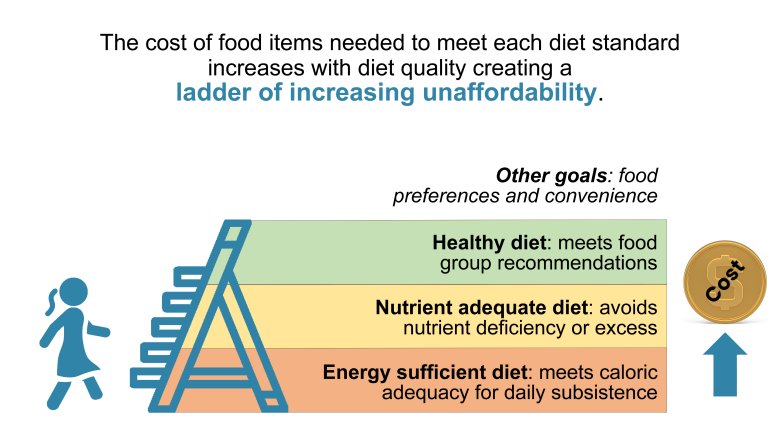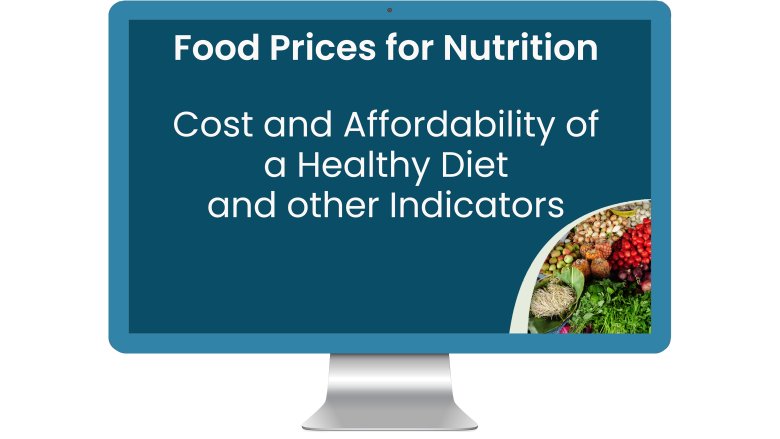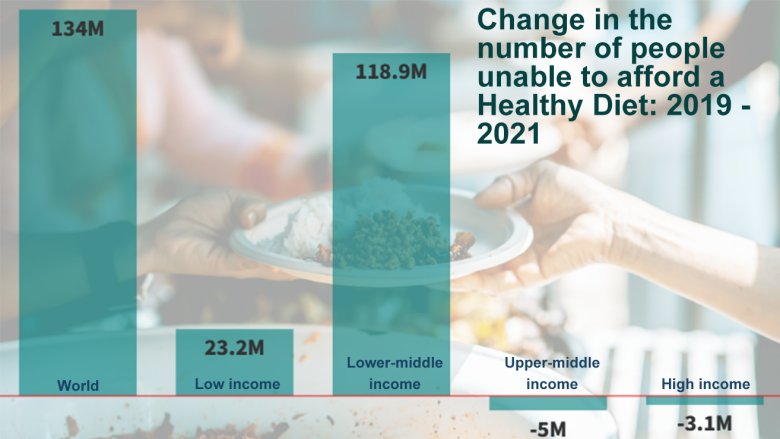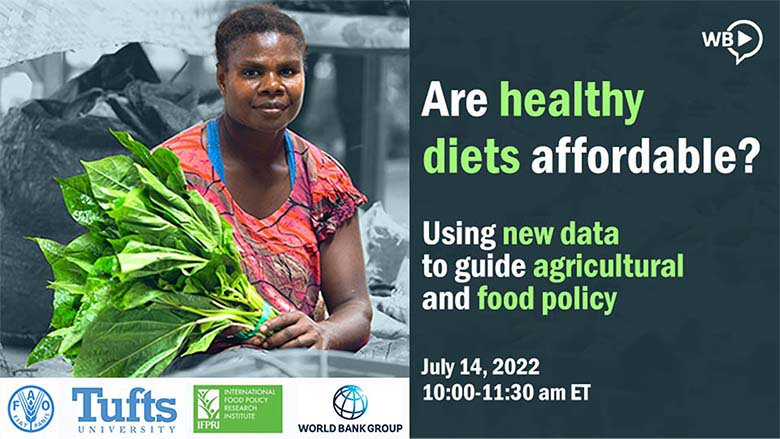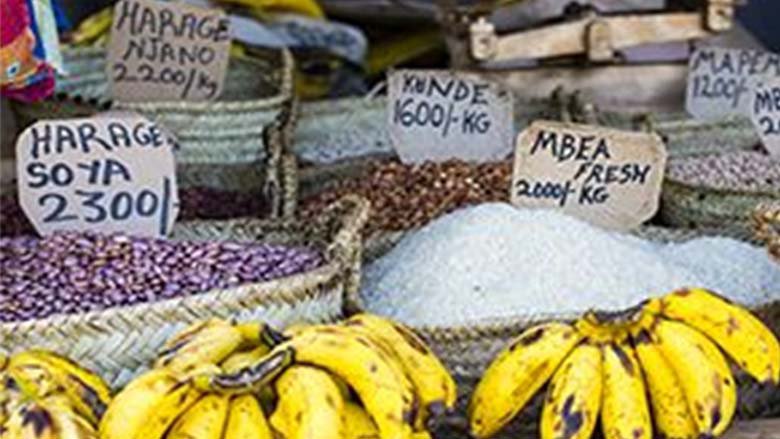The Food Prices for Nutrition DataHub provides access to global statistics on the cost and affordability of healthy diets and related indicators. These use food item availability and prices from the International Comparison Program (ICP), combined with food composition data and nutritional requirements from a wide range of sources including based on national dietary guidelines.
The 33 indicators and their metadata cover:
Diet cost
- Cost of a healthy diet, per person per day
- Cost of an energy sufficient diet and a nutrient adequate diet, per person per day
- Cost per person per day, cost share, and cost relative to starchy staples of different food groups (fruits; vegetables; starchy staples; animal-sourced foods; legumes, nuts and seeds; and oils and fats)
Diet affordability
- Prevalence of unaffordability and number of people unable to afford each diet
- Ratio of each diet cost to observed national average food expenditures
- Ratio of each diet cost to the food component of the international poverty lines as defined by the World Bank's income group classification
For further information on definitions and methods please refer to Methodology.
[ Back to page top ]
DATA HIGHLIGHTS
- Global food prices rose each year to 2022, largely driven by disruptions from COVID-19 and the war in Ukraine. The average cost of a healthy diet was $3.96 per person per day in current purchasing power parity (PPP) dollars, compared with $3.56 in 2021.
- In low-income countries, the average cost of a healthy diet was $3.48, while in high-income countries it was $3.78. Both lower-middle-income and upper-middle-income country groups recorded the highest cost of $4.20.
- These diet costs are much higher than the current international poverty line for low-income countries of $2.15 per person per day, and higher than the poverty line for lower-middle-income countries of $3.65. By considering the shares of household expenditure devoted to basic non-food needs for low-income consumers in each country income group based on recent household data compiled by the World Bank, we can establish a food poverty line for each. They are $1.35 (63% of $2.15) in low-income countries, $2.04 (56% of $3.65) in lower-middle-income countries, and $3.15 (46% of $6.85) in upper-middle-income countries. The cost of a healthy diet in each group far exceeds these values.
- Comparing these costs with income distribution data provides a measure of the affordability of the diet. Around 35% - or 2.8 billion - of the global population could not afford a healthy diet in 2022. Of those, 1.68 billion lived in lower-middle-income countries. The prevalence of unaffordability was highest in low-income countries where 71.5% of the population could not afford a healthy diet.
- Despite rising food prices, the prevalence of unaffordability fell across all income groups and most regions between the pre-pandemic year of 2019 and 2022. This is attributed to economic recovery despite rising food prices in recent years. The exception was Middle East & North Africa, where the share of people unable to afford a healthy diet rose slightly from 26.7% to 26.9%, and Sub-Saharan Africa where the share rose from 69.3% to 70.3%.
- The global number of people unable to afford a healthy diet fell to pre-pandemic levels in 2022, fueled by general economic recovery. However, this was uneven across regions with numbers slightly higher than in 2019 in Latin America and the Caribbean and in the Middle East and North Africa, and significantly higher in Sub-Saharan Africa, reaching 851.6 million in 2022, where a rising population impacted the numbers. In 2022, the number of people unable to afford a healthy diet dropped below pre-pandemic levels in the upper-middle- and high-income countries while lower-middle- and low-income countries recorded the highest levels since 2017.
- The cost of each of the six food groups making up the cost of a healthy diet in 2021 is also provided. The most expensive food group is animal-sourced foods, priced on average at $0.99 for the daily quantity needed in a healthy diet. For this food group, the highest cost is in low-income countries at $1.26 and in Sub-Saharan Africa at $1.18. Vegetables are the second most expensive at $0.75 globally, with Latin America & Caribbean having the highest cost of $0.98. Fruits cost $0.66 on average, and East Asia and Pacific has the highest cost of $0.94.?
- The cost of each food group relative to the cost of starchy staples ¨C often an easily accessible food providing calories ¨C is also provided. The cost of vegetables relative to starchy staples was highest in high-income countries at over two times the cost, while animal-source foods were over two times the cost of starchy staples in low-income countries in 2022.
[ Back to page top ]
[ Back to page top ]
Food Prices for Nutrition was established to provide governments and development agencies with accurate and updated metrics to inform agricultural, food systems, social protection, and health and nutrition interventions.
Food Prices for Nutrition's outputs ¨C indicators of the cost and affordability of diets and food groups and data for up to 180 countries - use observed consumer prices and household expenditures to provide an operational measure of peopleˇŻs access to locally available foods in the proportions needed for health.
The cost and affordability (CoAHD) indicators developed by Food Prices for Nutrition underlie the estimates published in United Nations' 2020 report (SOFI) that over 3 billion ¨C or two in five people on the planet - could not afford a healthy diet in 2017. These data were used to frame the . Ongoing global food inflation and supply shocks further underscore the need for timely data on the cost and affordability of healthy diets and nutritious food items and groups. The , as the authoritative source for internationally standardized statistics, indicators, and granular data, meets this need for a global cohort of policy makers, development analysts, and other users.
Since 2022, in close collaboration with Food Prices for Nutrition global partners, the World Bank and the Food and Agriculture Organization (FAO) have led the methodological improvement for these indicators, and systematically monitor and disseminate the data series. The latest data and estimates reported in the show that the total number of people unable to afford a healthy diet in 2022 was around about 2.8 billion, or 35.4% of the global population. This is a reduction in the global prevalence of unnaffordability following the peak of the COVID-19 pandemic in 2020. However, the recovery has been uneven, with a high share of the population still unable to afford a healthy diet in low-income countries and the sub-Saharan African region.
Food Prices for Nutrition supports efforts within the framework of the Sustainable Development Goals (SDGs) to end hunger, achieve food security and improved nutrition, and promote sustainable agriculture by 2030 (). It can also support the monitoring of progress towards the World BankˇŻs objective of building food systems that can feed everyone, everywhere, every day by promoting ˇ°nutrition-sensitive agricultureˇ± and improving food safety. FPN data assist policy makers and program analysts in guiding agricultural production and food distribution to ensure affordable healthy diets for all people at all times.
Food Prices for Nutrition is a partnership between , the and the World Bank. It is funded by the Bill & Melinda Gates Foundation and UK Aid, through the Foreign, Commonwealth & Development Office of the United Kingdom.
[ Back to page top ]
The Food Prices for Nutrition DataHub's diet cost and affordability indicators use the least cost combination of locally available foods to meet the needs of a representative adult requiring 2,330 kcal per day at three levels of diet quality: a healthy diet; a nutrient adequate diet; and an energy sufficient diet.
[ Back to page top ]
COST INDICATORS
- Cost of a Healthy Diet: A healthy diet meets nutritional standards set by dietary guidelines, with sufficient diversity and quantity within and between food groups to achieve nutrient adequacy and protect against diet-related diseases. To measure access and affordability, the cost of meeting food-based dietary guidelines is computed using the least expensive foods available in each category at each place and time (see "" and "Brief note: " (Herforth et al. 2022) ). The cost of a healthy diet is the preferred indicator of diet costs as it uses the most affordable foods available at local markets to meet dietary needs for an active and healthy life, using standards adopted by national governments around the world. Total cost per day can be disaggregated by food group, showing the cost per day of the least expensive locally available items in each food group (fruits; vegetables; starchy staples; animal-source foods; legumes, nuts, and seeds; and oils and fats)
- Cost of a Nutrient Adequate Diet: A nutrient adequate diet meets all essential nutrient requirements, with sufficient diversity and quantity of locally available foods to stay within the upper and lower bounds for total protein, fats, and carbohydrates as well as essential vitamins and minerals required to avoid nutrient deficiencies or toxicity. Computation of the least-cost nutrient adequate diet requires linear programming optimization modeling, and is based on nutrient requirements only, rather than food groups specified in dietary guidelines.
- Cost of an Energy Sufficient Diet: An energy sufficient diet provides enough of a starchy staple food for day-to-day subsistence, without either nutrient adequacy or adherence to dietary guidelines. The least-cost version of this subsistence diet uses the most affordable locally available starchy staple, achieving energy balance but not nutrient adequacy or other dietary needs.
For each of the diets listed above, costs per day are based on requirements for a median adult woman aged 19-30 in a healthy population as defined by the World Health Organization. For the Cost of a Nutrient Adequate Diet and the Cost an Energy Sufficient Diet, please refer to the Food Policy article (Bai et al. 2021). Information on the variation in the cost of nutrient adequacy by age, sex and reproductive status can be found in the Lancet article "" (Bai, Herforth and Masters 2022).
[ Back to page top ]
AFFORDABILITY INDICATORS
The affordability of each diet is measured by comparing diet costs to available income and four affordability metrics for each level of diet quality are calculated. According to an updated method applied in 2024, the first three indicators rely on the food expenditure share and basic non-food expenditure share of low-income consumers by countriesˇŻ income group classification, based on compiled by the World Bank. This updated method was also used for (SOFI) 2024 report. The fourth metric uses actual food expenditure. The metrics available are:
- The prevalence of unaffordability (PUA) of each level of diet quality, using household income or expenditure data for each country from the World BankˇŻs .
- The number of people unable to afford (NUA) each level of diet quality, using the prevalence of unaffordability multiplied by the total population in each country.
- The ratio of a countryˇŻs diet cost to the food component of the international poverty line, with the food component defined as the food expenditure share of low-income consumers multiplied by international poverty lines by countriesˇŻ income group classification.
- The ratio of a countryˇŻs diet costs to observed food expenditures per capita per day from national accounts, as reported by the International Comparison Program.
[ Back to page top ]
- October 28-30, 2024: Food Prices for Nutrition Stakeholder Convening on ˇ°Monitoring the Cost and Affordability of a Healthy Diet Within Countries and Globallyˇ±, Rome, Italy
- May 18, 2023: session on "Access to healthy diets"
- Nada Hamadeh, chair ¨C (pdf)
- Anna Herforth on measuring access as the cost & affordability of healthy diets [ (pdf), (pdf)]
- Kalyani Raghunathan on the cost & affordability of healthy diets in India [ (pdf), (pdf)]
- Rachel Gilbert on role of trade and import barriers in retail diet costs [ (pdf), (pdf)]
- Yan Bai on measuring diet costs with national data instead of prices reported to the ICP [ (pdf)]
- Discussants: (Nigeria), (Ghana)
- April 6, 2023: "Addressing the Global Food, Energy and Cost of Living Crises: The role of social protection in strengthening food systemsˇŻ resilience" [ (pdf), ]
- February 13, 2023 (12.00-18.30 CET) "Assessing the Data ˇ®QuantumˇŻ Leap in Agriculture and Food Systems: Consultations for New Strategic Directions" [ (pdf)]
- July 15, 2022 (10:00-11:30 am ET) "Are healthy diets affordable? Using new data on retail prices and diet costs to guide agricultural and food policy"
- July 14, 2022 (10:00-11:30 am ET) "Are healthy diets affordable? Using new data to guide agricultural and food policy" [ (pdf)]
- July 6, 2022 (10:00-12:00 ET) "State of Food Security in the World 2022"
Videos
- Tufts-FAO webinar on (25 min.)
- Harvard Chan School of Public Health nutrition seminar: (50 min.)
- Friedman School of Nutrition microcourse: (23 min.)
[ Back to page top ]
Papers, Blogs and Articles
- Roser M. (2024) . The New York Times
- Moncayo, J., Bai, Y., Cafiero, C., Conti, V., Herforth, A., Masters, W., and Rissanen, M. (2024)
- Bai, Y., Conti, V., Ebel, A., Cafiero, C., Herforth, A., Rissanen, M.O., Rosero Moncayo, J. & Masters, W.A. (forthcoming). Methods for monitoring the cost of a healthy diet based on price data from the International Comparison Program. FAO Statistics Division Working Paper. Rome, FAO.
- Bai, Y., Herforth, A., Cafiero, C., Conti, V., Rissanen, M.O., Masters, W.A. & Rosero Moncayo, J. (forthcoming). Methods for monitoring the affordability of a healthy diet. FAO Statistics Division Working Paper. Rome, FAO.
- Wallingford, J. K., de Pee, S., Herforth, A. W., Kuri, S., Bai, Y., & Masters, W. A. (2024). . Global Food Security, 41, 100771.
- Gilbert, R., L. Costlow, J. Matteson, J. Rauschendorfer, E. Krivonos, S.A. Block and W.A. Masters (2024). . World Development, 177: p.106535.
- Wallingford, J., E.M.Martinez and W.A. Masters (2023), . Global Food Security e100702. []
- (Annual progress report)
- Bai Y., J. Bouscarat, K. Sokourenko, P. Heinrigs, and K. Zougb¨¦d¨¦ (2023) , 31 July 2023. Also available in .
- Purdie E., Y. Bai, I. Song, and R. Costa (2023) , July 24, 2023.
- Rosero Moncayo J., N. Hamadeh, M. Rissanen, V. Conti, and Y. Bai (2023) , July 17, 2023.
- Bai Y., E. Purdie, M. Nsabimana, and M. Rissanen (2023) , May 15, 2023.
- Masters, W.A., E.M. Martinez, F. Greb, A. Herforth and S.L. Hendriks (2023). , in J. von Braun et al., eds, Science and Innovations for Food Systems Transformation, pages 603-623, January, 2 2023.
- Masters, W.A. and A. Herforth (2021). . The Conversation, July 9, 2021.
- Bai, Y. and W.A. Masters (2020), . World Bank data blog, May 26, 2020.
- Herforth, A. (2020). CSIS, Washington, September 23, 2020.
- Masters, W.A., Y. Bai, K. Hirvonen and D. Headey (2019), VoxDev column, December 13, 2019.
- Peinhardt, K. (2019), IFPRI blog post, June 6, 2019.
[ Back to page top ]
Media
- February 2024: Pakistani news coverage of Food Systems Dashboard conference featuring FPN project work on CoAHD in , , , ,
- January 2024: Nigerian news coverage of CoHD bulletin and press release in , , . ,
- June 2022: article on the true cost of food
- June 2022: (UK) + on world food prices
- May 2022: podcast on the global food price crisis
- February 2022: podcast on food prices and cost of healthy eating
- November 2021: article on food prices (in French) [ ungated ]
- March 2021: podcast on diet costs and affordability
- February 2021: article on food prices and diet costs
- December 2020: article on diet costs & affordability
[ Back to page top ]
Events
- October 16-20, 2023: (including Rachel Gilbert in a session on and , and Kay Dewey (with Y. Bai & W.A. Masters) poster on cost of infant feeding ())
- August 14-15, 2023: on diet and disease (including on Food choice and access to healthy diets: Evidence from food prices and diet costs worldwide
- February 13, 2023: on Assessing the Data ˇ®QuantumˇŻ Leap in Agriculture and Food Systems
- December 7, 2022: on food affordability
- September 26, 2022: AAEA online symposium
- July 31- Aug 2, 2022: presentations
- July 15, 2022: online
- July 14, 2022: event online
- July 6, 2022: at UN headquarters
[ Back to page top ]
Data access
online learning
Featured
NEWS AND CONVERSATION
Contact us at FPN@worldbank.org, and follow #FoodPricesForNutrition on and



